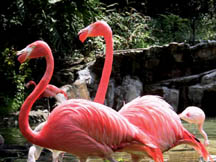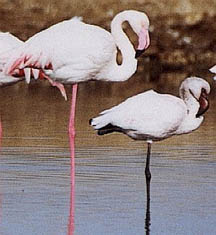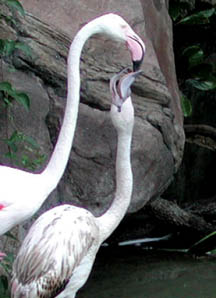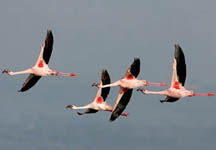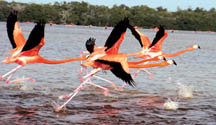|
observer |
|
|
|
|
|
OTHER LINKS |

|

|

|
|
|
|
|
In fact, the very name of these beautiful birds is associated with fire and is derived from the word flamenco which has its roots in Spanish, through Latin. For sometime, flamingoes were the cause of great confusion among ornithologists (scientists who study birds), as they couldn't decide whether these birds were more like ducks or storks. Finally, they classed them as a group by themselves.
There are five species of flamingoes throughout Africa, Asia, Europe and the Americas. Some of you may have seen these beauties since they are migrant birds and visitors to our land too. Let's find out more about these feathered friends.
What they look like
Flamingoes are not difficult to identify as they have feathers in hues of pink. Of course, there are some flamingoes that have more white than pink on their plumage, and they could be mistaken for storks.
|
|
Some of you may be aware of the fact that the colour of their feathers is influenced by the food these birds eat. We'll discuss this later when we look into their eating habits. Now, let's concentrate on their anatomy.
Flamingoes have very long necks, long pink coloured legs, big, pink patially webbed feet, orange eyes and a deep keeled (upside down) bill or beak which is yellow/orange or dark carmine red with a black tip. Their bills are very unusual in that they turn downward right in the middle as if they have been wrongly placed.
As these birds have necks and legs which are longer in proportion to body size than that of any other kind of bird, when flying, flamingoes appear to be doing so in almost a straight line.
Predators
|
|
Humans are their worst enemies as they destroy their habitats and their sources of food. As flamingoes do not compete with other animals for their food, they have few enemies. However, eagles and jackals attack flamingoes, especially the young.
Food and feeding system
Flamingoes eat insects, crustaceans (shrimp-like creatures), tiny plants such as algae and mollusks. The alpha and beta carotene in their food give them their unusual pink colour . Did you know that when we eat carrots, we eat beta carotene?
Spirulina, a blue-green algae makes up the entire diet of lesser flamingoes. Although it is called blue-green algae, it provides an orangish-red pigment. As most of the lesser flamingoes eat only this algae, they have more intense pink coloured feathers than greater flamingoes. Most greater flamingoes get their colour from the crustaceans which have eaten the blue-green algae. If the diet is low in carotene, then the feathers are more white than pink.
|
|
The flamingoes have a unique feeding system and their beaks are especially made for this. When it's mealtime, what the flamingoes do is stamp the muddy bottoms of lagoons with their partially webbed feet. This action helps to mix food particles with water. Then it takes in the water, rich in organisms and nutrients. How the flamingoes take in the water and then filter it, is what's unique. As the flamingoes have peculiar shaped beaks, they have to put their heads upside down in the water, looking backwards, to feed. Their filter feeding system is unlike any other bird's.
In fact, the filter feeding mechanism is structurally and mechanically different to that of even ducks. The flamingoes suck in the muddy, nutrient-mix water from the front portion of their beaks, and pump out the water from the sides. Briney plates called lamellae inside the beak act as strainers or tiny filters.
|
|
Swinging their upside down heads from side to side, or swashing the water with their fat tongues, they skim the water for tiny algae and crustaceans. Flamingoes can filter as much as 20 beakfuls of algae- rich water, in a single second. When it comes to quenching their thirst, then flamingoes look for fresh water.
Reproduction
Females are ready to become mothers by the time they reach six years. They pair off with a male to breed and both parents take turns to feed the nestlings. Flamingoes do not regurgitate (vomit) food like most other birds do, to feed the baby birds.
Instead, like pigeons, they too give the chicks a liquid substance known as crop milk, which is dark red in colour and very high in fat and protein.
|
|
Crop milk is a secretion of the upper digestive tract, stimulated by the hormone, prolactin. It is produced by both parents. The 'begging' call for food made by the chicks help produce crop milk in the parents.
The breeding pair takes up to six weeks to build a nest. It is usually built with mud, small stones and feathers on the ground in the shape of a volcano. The nest can be as high as a foot.
One or more eggs which are white in colour are laid and both parents incubate them for about 26-31 days. Once the eggs are hatched, the parent birds ensure that the chicks don't fall into the water.
The chicks have grey or white down feathers. They turn pink with age, mostly depending on the type of food available to them in the region. The chicks do not have a bent beak when they are born. It is straight, and red in colour. They also have plump, red or pink legs.
|
|
When the chicks are around a week-old, they venture out of their nests. They join other chicks and explore their home lakes, but wait for the parents to bring mouthfuls of water at mealtimes. Parents recognise their chicks by their vocalisation (voice). They will feed only their chicks. So if anything happens to the parents, the chicks starve to death.
Habitats and habits
Flamingoes live mostly in alkaline (opposite of acid) waters in warm, lush coastal areas, mangroves, lakes, lagoons with lots of mud and water and sandy islands. What's important to them is the depth of the water, not merely to facilitate their unusual feeding methods, but also to build nests.
|
|
Flamingoes are social birds and live in large groups called colonies. Tens of thousands of birds can live in one colony. The bigger kinds are known as the greater flamingoes and the smaller ones as lesser flamingoes.
If you observe them you will notice that when they need to fly, they first have to run a few paces to gather speed. However, this gathering of speed is not related to the ground, but rather to the air.


